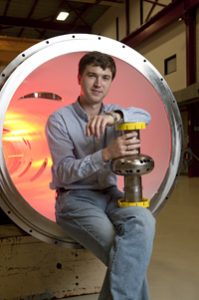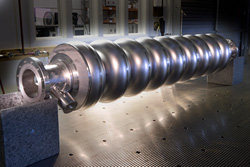
Alex Romanenko, sitting on the edge of a large cryogenic vessel, holds one of the superconducting RF cavities made of niobium. Photo: Fermilab (Click on image for larger version)
August 16, 2011 — Alex Romanenko, a materials scientist at Fermi National Accelerator Laboratory, will receive $2.5 million from the Department of Energy’s Office of Science to expand his innovative research to develop superconducting accelerator components. These components could be applied in fields such as medicine, energy and discovery science.
Romanenko was named a recipient of a DOE Early Career Research Program award for his research on the properties of superconducting radio frequency cavities made of niobium metal. The prestigious award, which is given annually to the most promising researchers in the early stages of their careers, includes a $2.5 million award over five years to continue work in the specified area.
“Dr. Romanenko and his proposed research show great promise,” said Tim Hallman, associate director of the DOE’s Office of Science for Nuclear Physics. “We are pleased that he has been selected to receive an Early Career Research Program award to continue this work.”
Romanenko’s work could explain why some superconducting radio frequency cavities are highly efficient at accelerating charged particles to high speeds while others are not, as well as prescribe new ways to make cavities even more powerful. His research links the performance of SRF cavities to the quality of the niobium metal used to make them. In particular, he investigates specific defects and impurities in niobium. Although scientists take painstaking measures to ensure that the niobium is completely pure and that the final SRF cavities are free from any contaminants, dust or debris, the cavities do not always perform the way that they should. Romanenko’s research is dedicated to finding out why that happens.
Romanenko began his research on SRF cavities as a graduate student at Cornell University, an institution known for its SRF research. He continued his award-winning work at Fermilab when he joined the laboratory in 2009 as a Peoples Fellow, a prestigious position given to scientists who have the potential to be leaders in their field. (More information at http://www.fnal.gov/pub/today/archive_2011/today11-03-02.html)

Strung together like the pearls of a necklace and cooled to ultralow temperatures, SRF cavities can accelerate particles with high efficiency. Photo: Fermilab (Click on image for larger version)
Through his research, Romanenko found that a new, previously unexplored, type of defect near the cavity surface may result in surface differences that are responsible for a cavity’s inferior performance. What he found was surprising: the defect sites often contained niobium-hydrogen compounds, which might form when the cavities are prepared for operation. Specifically, he was able to pinpoint the problematic area to the first 40 nanometers of a cavity’s surface, a thickness equivalent to 120 layers of niobium atoms.
“The technology of these cavities has developed so fast recently that it is ahead of the corresponding science,” Romanenko explained. “We know how to make them work to a certain level of performance, but do not necessarily understand the full physics behind why they do so. I hope to understand why cavities behave in certain ways first, improve on this and then apply what I learn to other materials.”
If Romanenko can isolate the specific nanostructural effects that cause problems in cavities, then Lance Cooley, Romanenko’s supervisor and head of the new Superconducting Materials Department in Fermilab’s Technical Division, is prepared to direct other scientists to develop ways to prevent or control them and transfer that knowledge to industry. This could someday make it possible to mass-produce nearly perfect niobium cavities as well as lay the groundwork for cavities made from other superconducting materials that can perform at higher temperatures and accelerating fields. Such high-performance cavities—strung together to create powerful, intense particle beams—would lead to accelerators that can be used in industry, in hospitals and at research institutions. These accelerators are needed, for example, to produce a range of radioisotopes for medical diagnostics and have the potential to treat nuclear waste, among other applications. (More information at http://www.acceleratorsamerica.org/applications/index.html)
“This award recognizes the high caliber of research that takes place at Fermilab,” Cooley said. “It is because of the laboratory’s existing world-class research program that Alex’s research is likely to succeed.”
The monetary award will cover part of Romanenko’s research efforts, fund a postdoctoral associate and a part-time technician, and pay for advanced analysis techniques used to examine surfaces in the next five years.
Fermilab is a national laboratory supported by the Office of Science of the U.S. Department of Energy, operated under contract by Fermi Research Alliance, LLC.
The DOE Office of Science is the single largest supporter of basic research in the physical sciences in the United States, and is working to address some of the most pressing challenges of our time. For more information, please visit http://science.energy.gov



